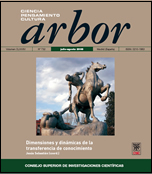The Oslo Manual and the social innovation
DOI:
https://doi.org/10.3989/arbor.2008.i732.210Keywords:
Oslo’s Handbook, social innovation, indicatorsAbstract
The Oslo’s Handbook (2005) analyse four types of innovations: processes, goods, organization and marketing. However, there are social innovations not oriented to markets. This paper proposes a conceptual framework to identify good practices of social innovation, which is based on different kinds of values which are satisfied by innovation practices (axiological conception). The social acceptation and use of innovative proposals is the main criteria to construct systems of indicators of social innovation. Different sources, scopes and types of innovation should be distinguished. As a conclusion, a new research program is proposed for the studies of innovation.
Downloads
References
Bozemann, B. (2000): “Technology transfer and public policy: a review of research and theory”, Research Policy, 29, 627-655. doi:10.1016/S0048-7333(99)00093-1
Bruland, C. (2001): “Technological revolution, innovation systems and convergence from a historical perspective, document for the CONVERGE Program”, UE-SOE2-CT98-2047, 24 pp.
Bush, V. (1945): Science: the Endless Frontier, Washington, United States Government Printing.
Drucker, P. (1994): “Knowledge Work and Knowledge Society”, JFK School of Government, Harvard University.
Echeverría, J. (2003): La revolución tecnocientífica, Madrid, Fondo de Cultura Económica.
Echeverría, J. (2006): “Modelo pluralista de innovación: el ejemplo de las Humanidades”, en A. Ibarra, J. Castro y L. Rocca (eds.), Las ciencias sociales y las humanidades en los sistemas de innovación, Estudios de Ciencia Tecnología e Innovación, 2, 135-155, UPV/EHU, Cátedra Sánchez-Mazas.
Etzkowitz, H. y Leydesdorff, L. (2001): “The dynamics of innovation: From National Systems and ‘Mode 2’ to a Triple Helix of University-Industry-Government Relations”, Research Policy 29(2), 109-123. doi:10.1016/S0048-7333(99)00055-4
Gibbons, M., Limoges, C.; Nowotny, H.; Schwartzman, S.; Scott, P. y Trow, M. (1994): The new production of knowledge. The dynamics of science and research in contemporary societies, Sage Publications.
Hippel, E. von (1988): The Sources of Innovation, New York, NY; Oxford Univ. Press & traducida al castellano con el título Usuarios y suministradores como fuentes de innovación, Madrid, COTEC, 2004).
Hippel, E. von (2005): Democratizing Innovation, Cambridge, Mass., MIT Press.
INJUVE (2002): “Los jóvenes y el teléfono móvil”, número monográfico de la Revista de Estudios de Juventud, 57, junio 2002, Madrid, Instituto Nacional de la Juventud.
Lundvall, B. A (1992): National Systems of Innovation: Towards a Theory of Innovation and Interactive Learning, London, Pinter Publ.
Nelson, R. R. (1993): National Systems of Innovation, Oxford, Oxford Univ. Press.
OECD/European Communities (2005): Oslo Manual: Guideliness for Collecting and Interpreting Innovation Data, 3d. ed., OECD/EC. TIC y Discapacidad (2007): Madrid, Fundación Vodafone.
Downloads
Published
How to Cite
Issue
Section
License
Copyright (c) 2008 Consejo Superior de Investigaciones Científicas (CSIC)

This work is licensed under a Creative Commons Attribution 4.0 International License.
© CSIC. Manuscripts published in both the printed and online versions of this Journal are the property of Consejo Superior de Investigaciones Científicas, and quoting this source is a requirement for any partial or full reproduction.
All contents of this electronic edition, except where otherwise noted, are distributed under a “Creative Commons Attribution 4.0 International” (CC BY 4.0) License. You may read the basic information and the legal text of the license. The indication of the CC BY 4.0 License must be expressly stated in this way when necessary.
Self-archiving in repositories, personal webpages or similar, of any version other than the published by the Editor, is not allowed.














